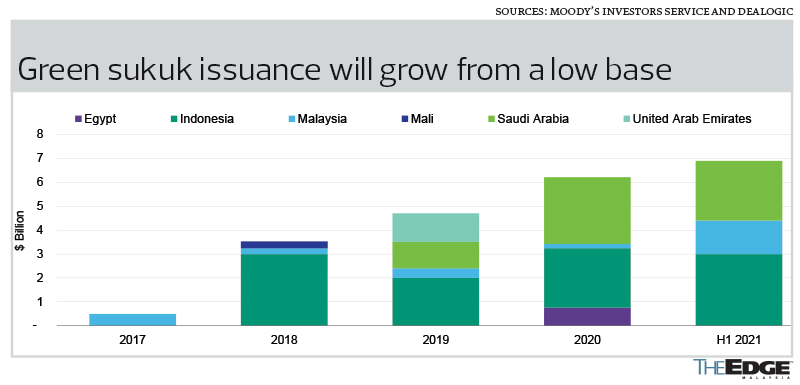
This article first appeared in The Edge Malaysia Weekly on September 13, 2021 - September 19, 2021
GLOBAL sukuk issuance is likely to bounce back as early as next year after flat growth this year, Moody’s Investors Service predicts. “Early signs indicate we will have a return to the positive trend as soon as 2022. This is supported by our expectation of new entrants to the markets, as well as the refinance of maturing sukuk in 2022,” Ashraf Madani, a vice-president and senior analyst at Moody’s, tells The Edge.
In a report last week, Moody’s had forecast that global sukuk issuance would see flat or slightly lower growth this year after five straight years of strong growth that culminated in record issuance last year.
The cautious projection is despite the strong start to the year, with some US$102 billion in sukuk issued in 1H2021, up 3% year on year, driven mainly by issuances in Malaysia and Indonesia.
Moody’s attributed the expected slowdown in issuances this year to higher oil prices, which have reduced sovereign funding needs in Gulf Cooperation Council (GCC) countries.
It projects sukuk issuance this year at between US$190 billion and US$200 billion, after a record US$205 billion in 2020. Malaysia will continue to dominate sales, with activity primarily denominated in the local currency.
“The coronavirus pandemic widened fiscal deficits across major sukuk-issuing sovereigns in 2020 and higher borrowing needs pushed issuance above the US$200 billion mark for the first time. However, higher oil prices will increase GCC sovereigns’ revenue and narrow their fiscal deficits in 2021, leading to lower issuance activity,” it says in the report co-authored by Madani.
The fiscal deficits of Southeast Asian issuers such as Malaysia and Indonesia, however, are expected to remain wider for longer.
Madani sees sukuk activity in Malaysia continuing to grow this year. “This will be supported by higher volumes across the various issuing sectors — sovereign, financial institutions, corporates. We expect the growth in issuance to range between 15% and 20%,” he tells The Edge.
Despite the expected consolidation in global issuances this year, Moody’s sees the sukuk market maintaining its long-term growth trend. This is based on its expectation of new entrants to the market, low penetration and innovative new Islamic products such as green and sustainable sukuk.
“Longer term, our projection is for sukuk issuance to continue to expand, supported by rising interest from both issuers and investors. More sovereign issuers are promoting their Islamic finance agendas and are increasing the share of sukuk in their funding mix whenever market conditions are favourable,” it says.
Those who made debut sukuk issuances this year included Saudi Arabian Oil Company (Saudi Aramco), which raised US$6 billion in June from selling US-dollar-denominated sukuk, and the Maldives government which raised US$200 million.
Moody’s notes that with the appeal of sukuk as an investment tool growing, as evidenced by the high demand for issuances, it has become the norm for order books to exceed the offered amount by three or four times, especially for creditworthy borrowers.
Interestingly, demand for the instruments is increasingly coming from international players in markets less exposed to Islamic finance, it says.
Despite the demand, sukuk remains underrepresented in global finance, comprising only 5% of global financial assets.
Rising interest in green sukuk
Madani also expects the healthy growth in green sukuk issuances to continue this year. “Market participants are becoming more familiar with the instrument and it has actually become a frequent funding tool for some issuers, like the government of Indonesia. We expect issuance to be diversified across corporates, sovereigns and supranationals,” he says.
He notes that in Southeast Asia, Indonesia has been the most active in the green sukuk market in terms of volume, while Malaysia takes the lead in terms of number of participants and depth of market.
“[We] expect green sukuk issuance to accelerate in the coming years, particularly in Southeast Asia and GCC as they seek to attract private capital to low-carbon and climate-resilient infrastructure projects,” Madani says in the Moody’s report, noting that the latest issuance was a US$750 million five-year instrument from the Indonesian government to finance sustainable projects.
Indonesia now has three green sukuk listings on Nasdaq Dubai, including the world’s first sovereign green sukuk, issued in March 2018 for US$1.25 billion. Saudi Arabia-based Islamic Development Bank issued its second tranche under its sustainable finance programme for US$2.5 billion in March this year with the money raised to be used to finance or refinance eligible green and sustainable projects.
“We expect Indonesia and Saudi Arabia to continue their lead in the green and sustainable sukuk market,” Madani says.
Save by subscribing to us for your print and/or digital copy.
P/S: The Edge is also available on Apple's App Store and Android's Google Play.

